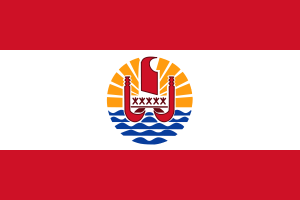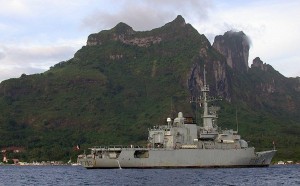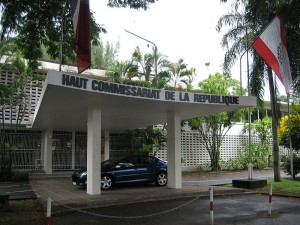French Polynesia

History of French Polynesia
Up until recent times, all of Tahiti’s’ guests have arrived by sea , and the Kay , here along the Boulevard Pomare, is the heart of the city. These modern adventurers follow in a time-honored tradition. Tahiti has been known as a mecca for world cruising voyagers, ever since the first explorers arrived. France is only the latest of nations to drop anchor in Tahitian waters. Captain Cook made three voyages here in 1769, 1773 and 1777. Not only did Cook give the European world the first complete map of the entire Pacific, but his journals and the records of his ship’s historian and artist, brought straight-forward accounts of the cultures of Tahiti and The Society Islands to the attention of the rest of the world. It was Captain Cook who established Papeete as the cultural and political center of the islands. Before the Europeans, the islanders lived in territories divided by river valleys and mountains. Cook wrongly concluded that the then chief of Papeete was the chief of all Tahiti and gave him tools made of iron, which the islanders had never seen. With these, the chief made war canoes so quickly that by the turn of the century he became, in fact, the chief of the whole island, having defeated all his rivals. In the 1820s, Queen Pomare expanded the village to trade with whalers, Navy ships and merchants and it was a thriving center when France annexed it j as a protectorate in 1842.
French Polynesia (![]() i/ˈfrɛntʃ pɒlɨˈniːʒə/; French: Polynésie française,pronounced: [pɔlinezi fʁɑ̃sɛz]; Tahitian: Pōrīnetia Farāni) is an overseas country (pays d’outre-mer) of the French Republic. It is made up of several groups of Polynesian islands, the most famous island being Tahiti in the Society Islands group, which is also the most populous island and the seat of the capital of the territory (Papeetē). Although not an integral part of its territory, Clipperton Island was administered from French Polynesia until 2007.
i/ˈfrɛntʃ pɒlɨˈniːʒə/; French: Polynésie française,pronounced: [pɔlinezi fʁɑ̃sɛz]; Tahitian: Pōrīnetia Farāni) is an overseas country (pays d’outre-mer) of the French Republic. It is made up of several groups of Polynesian islands, the most famous island being Tahiti in the Society Islands group, which is also the most populous island and the seat of the capital of the territory (Papeetē). Although not an integral part of its territory, Clipperton Island was administered from French Polynesia until 2007.
History
 The French frigate Floréal in November 2002, stationed in Bora Bora lagoon.
The French frigate Floréal in November 2002, stationed in Bora Bora lagoon.
The island groups that make up French Polynesia were not officially united until the establishment of the French protectorate in 1889. The first of these islands to be settled by indigenous Polynesians were the Marquesas Islands in AD 300 and the Society Islands in AD 800. The Polynesians were organized in loose chieftainships.
European communication began in 1521 when the Portuguese explorer Ferdinand Magellan, sailing in the service of the Spanish Crown, sighted Puka-Puka in the Tuāmotu-Gambier Archipelago. Dutchman Jakob Roggeveen came across Bora Borain the Society Islands in 1722, and the British explorer Samuel Wallis visited Tahiti in 1767. The French explorer Louis Antoine de Bougainville visited Tahiti in 1768, while the British explorer James Cook visited in 1769. In 1772 The Spanish Viceroy of Peru Don Manuel de Amat ordered a number of expeditions to Tahiti under the command of Domingo de Bonechea who was the first European to explore all of the main islands beyond Tahiti. A short-lived Spanish settlement was created in 1774. Some maps still bear the name Isla de Amat for Tahiti, which was named after Viceroy Amat in the 18th century. Christian missions began with Spanish priests who stayed in Tahiti for a year. Protestants from the London Missionary Society settled permanently in Polynesia in 1797.
King Pōmare II of Tahiti was forced to flee to Mo’orea in 1803; he and his subjects were converted to Protestantism in 1812. French Catholic missionaries arrived on Tahiti in 1834; their expulsion in 1836 caused France to send a gunboat in 1838. In 1842, Tahiti and Tahuata were declared a French protectorate, to allow Catholic missionaries to work undisturbed. The capital of Papeetē was founded in 1843. In 1880, France annexed Tahiti, changing the status from that of a protectorate to that of a colony.
In the 1880s, France claimed the Tuamotu Archipelago, which formerly belonged to the Pōmare Dynasty, without formally annexing it. Having declared a protectorate over Tahuata in 1842, the French regarded the entire Marquesas Islands as French. In 1885, France appointed a governor and established a general council, thus giving it the proper administration for a colony. The islands of Rimatara and Rūrutu unsuccessfully lobbied for British protection in 1888, so in 1889 they were annexed by France. Postage stamps were first issued in the colony in 1892. The first official name for the colony was Établissements de l’Océanie (Settlements in Oceania); in 1903 the general council was changed to an advisory council and the colony’s name was changed to Établissements Français de l’Océanie (French Settlements in Oceania).
In 1940, the administration of French Polynesia recognised the Free French Forces and many Polynesians served in World War II. Unknown at the time to French and Polynesians, the Konoe Cabinet in Imperial Japan on 16 September 1940 included French Polynesia among the many territories which were to become Japanese possessions in the post-war world – though in the course of the war in the Pacific the Japanese were not able to launch an actual invasion of the French islands.
In 1946, Polynesians were granted French citizenship and the islands’ status was changed to an overseas territory; the islands’ name was changed in 1957 to Polynésie Française (French Polynesia). In 1962, France’s early nuclear testing ground of Algeria became independent and the Maruroa atoll in the Tuamotu Archipelago was selected as the new testing site; tests were conducted underground after 1974. In 1977, French Polynesia was granted partial internal autonomy; in 1984, the autonomy was extended. French Polynesia became a full overseas collectivity of France in 2003.
In September 1995, France stirred up widespread protests by resuming nuclear testing at Fangataufa atoll after a three-year moratorium. The last test was on 27 January 1996. On 29 January 1996, France announced that it would accede to the Comprehensive Test Ban Treaty, and no longer test nuclear weapons.
Politics of French Polynesia takes place in a framework of a parliamentary representative democratic French overseas collectivity, whereby the President of French Polynesia is the head of government, and of a multi-party system. Executive power is exercised by the government. Legislative power is vested in both the government and the Assembly of French Polynesia (the territorial assembly).
Political life in French Polynesia has been marked by great instability since the mid-2000s. On 14 September 2007, the pro-independence leader Oscar Temaru, 63, was elected president of French Polynesia for the 3rd time in 3 years (with 27 of 44 votes cast in the territorial assembly). He replaced former President Gaston Tong Sang, opposed to independence, who lost ano-confidence vote in the Assembly of French Polynesia on 31 August after the longtime former president of French Polynesia, Gaston Flosse, hitherto opposed to independence, sided with his long enemy Oscar Temaru to topple the government of Gaston Tong Sang. Oscar Temaru, however, had no stable majority in the Assembly of French Polynesia, and new territorial elections were held in February 2008 to solve the political crisis.
 The Assembly of French Polynesia.
The Assembly of French Polynesia.
The party of Gaston Tong Sang won the territorial elections, but that did not solve the political crisis: the two minority parties of Oscar Temaru and Gaston Flosse, who together have one more member in the territorial assembly than the political party of Gaston Tong Sang, allied to prevent Gaston Tong Sang from becoming president of French Polynesia. Gaston Flosse was then elected president of French Polynesia by the territorial assembly on 23 February 2008 with the support of the pro-independence party led by Oscar Temaru, while Oscar Temaru was elected speaker of the territorial assembly with the support of the anti-independence party led by Gaston Flosse. Both formed a coalition cabinet. Many observers doubted that the alliance between the anti-independence Gaston Flosse and the pro-independence Oscar Temaru, designed to prevent Gaston Tong Sang from becoming president of French Polynesia, could last very long.
At the French municipal elections held in March 2008, several prominent mayors who are member of the Flosse-Temaru coalition lost their offices in key municipalities of French Polynesia, which was interpreted as a disapproval of the way Gaston Tong Sang, whose party French Polynesian voters had placed first in the territorial elections the month before, had been prevented from becoming president of French Polynesia by the last minute alliance between Flosse and Temaru’s parties. Eventually, on 15 April 2008 the government of Gaston Flosse was toppled by a constructive vote of no confidence in the territorial assembly when two members of the Flosse-Temaru coalition left the coalition and sided with Tong Sang’s party. Gaston Tong Sang was elected president of French Polynesia as a result of this constructive vote of no confidence, but his majority in the territorial assembly is very narrow. He offered posts in his cabinet to Flosse and Temaru’s parties which they both refused. Gaston Tong Sang has called all parties to help end the instability in local politics, a prerequisite to attract foreign investors needed to develop the local economy.
Relations with France
 High Commission of the French Republic.
High Commission of the French Republic.
Despite a local assembly and government, French Polynesia is not in a free association with France, like the Cook Islands with New Zealand or the Federated States of Micronesia with the United States. As a French overseas collectivity, the local government has no competence in justice, education, security and defense, directly provided and administered by the Government of France, the Gendarmerie, and French military forces. The highest representative of the State in the territory is the High Commissioner of the Republic in French Polynesia (French: Haut commissaire de la République).
French Polynesia also sends three deputies to the French National Assembly, one representing the Leeward Islands administrative subdivision and the south-western suburbs of Papeete, another one representing Papeete and its north-eastern suburbs, plus the commune (municipality) of Mo’orea-Mai’ao, the Tuāmotu-Gambier administrative division, and the Marquesas Islands administrative division, and the last one representing the rest of Tahiti and the Austral Islands administrative subdivision. French Polynesia also sends two senators to the French Senate.
French Polynesians vote in the French presidential elections and at the 2007 French presidential election, in which the pro-independence leader Oscar Temaru openly called to vote for the Socialist candidate Ségolène Royal while the parties opposed to independence generally supported the center-right candidate Nicolas Sarkozy, the turnout in French Polynesia was 69.12% in the first round of the election and 74.67% in the second round. French Polynesians voters placed Nicolas Sarkozy ahead of Ségolène Royal in both rounds of the election (2nd round: Nicolas Sarkozy 51.9%; Ségolène Royal 48.1%).



